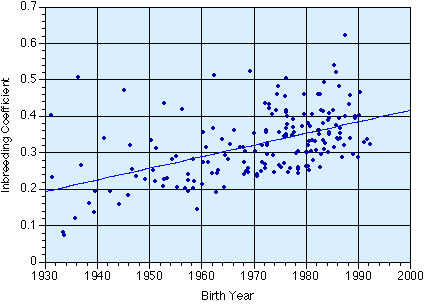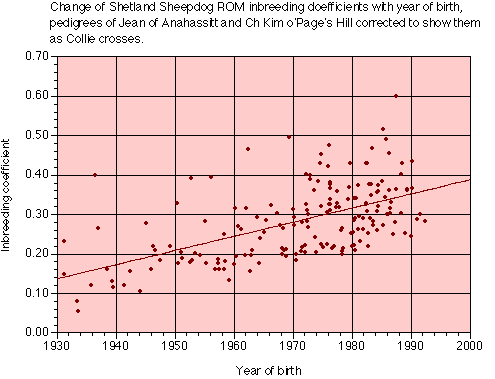Inbreeding coefficients for ROM Shetland Sheepdogs
American Shetland Sheepdogs, at least as indicated by those Shelties that have earned the Register of Merit or ROM (sire of at least 10 Champions or dam of at least 5) have 160 ancestors of unknown pedigree. These ancestors, however, contribute very unevenly to the modern Shetland Sheepdog. When to this is added the fact that the modern American Sheltie is bred from a relatively small number of imported dogs, many closely related to each other, it is hardly surprising that inbreeding coefficients for the Register of Merit Shelties are high, and have increased steadily since the initial importations, which took place during the 1920's. Each dot on the figure below represents one ROM Sheltie. Note that the average value for a recent ROM Sheltie is probably in excess of 40% - equivalent to between two and three generations of brother-sister matings. Individual inbreeding coefficients are available for the ROM Shelties as of about 1990.
.Note that the highest values on the left side of the plot are incorrect, due to the fact that two early suspected Collie crosses (Jean of Anahassitt and Ch Kim o'Page's Hill) were placed in the database with their paper (purebred Sheltie) pedigrees. We now have the inbreeding coefficients for the ROM Shelties with the assumption that Jean of Anahassitt and Ch Kim o'Page's Hill were sired by unrelated Collies. Although some of the high early values are lowered considerably, the effect on modern ROM dogs is a reduction of the inbreeding coefficient of only about .03. The plot below is thought to be closer to the truth.
The concept of the inbreeding coefficient can be extended to the kinship coefficient, where instead of calculating the inbreeding coefficient for an individual, one calculates the inbreeding coefficient for the hypothetical offspring of two individuals. This is called the kinship coefficient. The kinship coefficient between two full siblings (assuming their parents have no common ancestors) is 25%, which is the same as the kinship coefficient between an outcrossed parent and its offspring. A reasonably high degree of inbreeding in an individual is not an overwhelming problem, as mating between two individuals, both with high inbreeding coefficients but with few ancestors in common, will produce animals with quite low inbreeding coefficients. But what happens when the kinship coefficient of a dog with every possible mate is high?
In the case of Shelties, the kinship coefficient between any two ROM Shelties whelped since 1980 averages 33%, with a highest value of 62% (A/C Ch Alfenloch Ryan o'Neill ROM x Ch Mainstay Cemeo Farms Model ROM) and a lowest value of 25% - the equivalent of full siblings. In other words, every Register of Merit Sheltie is as closely related to any other ROM Sheltie as if they were littermates from unrelated parents. We clearly do not have a large gene pool, at least not in the top show lines, although we do have a large number of individual dogs.
One interesting point is that Shelties are notorious for not breeding "true" - multiple champion litters are rare, with particular problems in getting a litter which is all in size and all have correct ears. Is it possible that some of the traits selected for via the show ring are in fact dependant on heterozygosity at some loci?
Back to Genetics index
sbowling@mosquitonet.comupdated March 8, 2010


